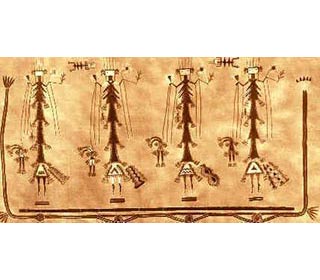Sand Paintings conveyed ideas in basic pictures and due to the materials and methods used to create sand paintings they were often of a temporary nature. Depictions of Navajo spirits called Yei are commonly found on Petroglyphs and Sand Paintings. Yei derives from the word Yeibicheii meaning the Holy People. Sand Paintings were created to exist for only a few hours however, a movement by Native Americans in the late half of the 1900's created permanent Sand Painting as an art form. As sandpaintings are sacred an pieces created for exhibition or commercial purposes use reversed colors and variations. Sand Painting Surface
The size of a sand painting ranged from 2 square feet to as much as 20 square feet if created indoors. An outdoor surface might be used or the ground of a hogan, or on a buckskin or cloth sheet or cover. It might take many hours to create a large painting and up to 12 people worked on their creation. Sacred Navajo sand paintings are created and destroyed between sunrise and sunset of one day. Sand Painting Purpose
The sacred art of sand painting had very specific purposes. The most prevalent reasons for creating a sand painting to heal the sick and to offer blessings. The blessings are offered to mark important and special occasions such as births, marriages and new homes. Sand Painting Ceremonies
The sand painting ceremonies center around a purification ceremony. When the painting is finished the person to whom the painting is directed is seated on the painting and parts of it are rubbed on to the body. the Shaman will chant, asking the Yeibicheii, or Yei, to come into the painting and help heal the patient. Purification occurs as evil humors are driven from the person into the sand painting and healing begins. The sickness absorbed by the sand painting is buried or swept away as part of the ceremony. Just as the gods draw pictures upon the moving clouds, so the shamans make paintings on the sand, and when the purpose of the drawing has been fulfilled it is removed without a trace by a sweep of the hand. Materials used for a Sand Painting
Various materials are used in the art of sand painting. Sand painting is the art of pouring colored sands, powdered or ground pigments from minerals or crystals, and pigments from other natural stones and rocks on to a base of smooth sand to make a sand painting. Occasionally other materials were used such as roots, cornmeal and flower pollen. These materials were used with charcoal to create a variety of colors. The colors of the sands was extremely important in creating sand paintings. Colors used for a Sand Painting
The design for a sand painting is created using five sacred colors of sand. Each of the colors used in Sand Paintings have a specific meaning and each color represents a physical direction. The Navajo tribe believe that the colors yellow, blue, white, and black were of great significance as they represent four sacred mountains and the four cardinal directions. - Blue: The blue mountains brought the dawn and represented the South
- Yellow: The yellow mountains represented twilight and the West
- Black: The black mountains brought the night and represented the North
- White: When the white mountains rose it was day and represented the East
- Red: The color red was also used that represented the sunshine and the Spiritual life
Colors used for a Sand Painting - Creating the Colors
Colored sands were used to create a sand painting. Common sand was worked, or mixed, with various stones and rocks to create the desired colors for the sand paintings: - Blue sands: Criscola is a rich blue stone with deep green flecks and used for creating blue sands
- Yellow sands: Sandstone is a rock consisting of sand or quartz grains cemented together and typically red, yellow or brown in color and predominantly used to creating yellow sands
- Black sands: Magnetite is black iron oxide containing tiny black, metallic crystals and this, or charcoal, is used for creating black sands
- White sands: Gypsum is a very soft, white stone, made of calcium sulphate, and used for creating white sands
- Red sands: Sandstone of clay was used for red sands
The Medicine Man mixed the sands in order to create variations of colors for a sand painting. Method and Technique for creating a Sand Painting
As many as 12 people might work on a single painting however the design and pattern is determined by the Shaman or Medicine Man. There are hundreds of different traditional designs for sand paintings which are known to the Navajo and more than 30 different sand paintings might be associated with one ceremony. The Shaman pre-determines the design of the sand painting and instructs his helpers on how to create the required pattern and design. The method and technique used to create a sand painting is as follows: - Clean white sands are placed onto the surface for the sand painting creating a bed for the painting
- The ground minerals (sands) are sifted through the fingers of the artists
- Only one color is worked with at one time
- Dark sands are used first
| 